White Mold Management in Soybeans
Crop Insights
Written by Mark Jeschke, Ph.D., Pioneer Agronomy Manager
Crop Insights
Written by Mark Jeschke, Ph.D., Pioneer Agronomy Manager
White mold (Sclerotinia sclerotiorum) is a fungal disease that can attack hundreds of plant species. Also known as Sclerotinia stem rot, white mold was first observed on soybeans in central Illinois in 1948 and for many years was only a sporadic soybean disease in Minnesota, Wisconsin, and Michigan. However, since the 1990s it has become a more frequent threat to northern states from Minnesota to New York., as well as the northern areas of states bordering to the south.
The reason for the abrupt increase in the frequency and severity of white mold infection is not fully understood. Changes in soybean management practices likely have played a role. Practices such as earlier planting, longer maturity varieties, and narrow row spacing that have been important in driving higher soybean yields also tend to create a more favorable environment for white mold disease development by accelerating canopy closure during the season. Changes in genetic resistance of commercial soybean varieties, as well as changes in the pathogen itself may also be factors.
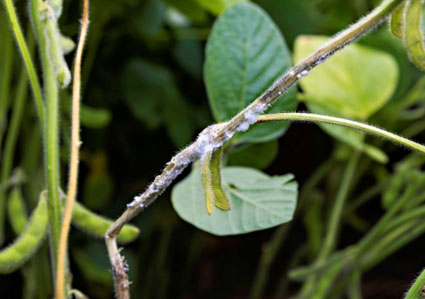
Figure 1. White fungal mycelia visible on the stem of a soybean plant infected with white mold.
A successful management plan for white mold in soybean needs to take factors such as variety selection and agronomic management into account, in addition to any chemical control treatments.
White mold is a monocyclic disease, which means that it goes through one development cycle per crop cycle. White mold persists in soybean fields over time by survival structures called sclerotia. These dark, irregularly shaped bodies about ¼ to ½ inch long are formed within the white, cottony growth both inside and outside the stem. Sclerotia contain energy reserves and function much like seeds, surviving for years in the soil and eventually germinating, producing millions of spores beneath the plant canopy.

Figure 2. Mushroom-like apothecia forming on sclerotia.
(Image courtesy of the Plant Disease Clinic, Extension Plant Pathology, University of Minnesota.)
In the most common form of germination, a sclerotium produces one or more germ tubes or stipes that grow upward from a depth of two inches or less in the soil. When it reaches the soil surface, the germ tube is triggered by light to produce a small, flesh-colored structure much like a mushroom, called an apothecium. One sclerotium can produce numerous apothecia simultaneously or sequentially throughout the growing season. Each apothecium produces millions of spores beneath the plant canopy, which are periodically released and spread to the plants.
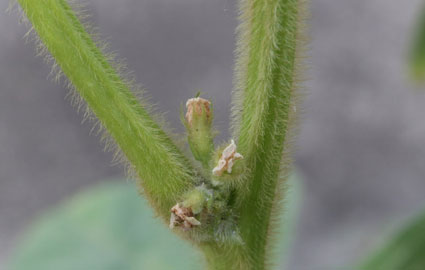
Figure 3. Senescing flowers are the entry point for the white mold pathogen to infect the plant.
White mold spores are not able to invade plants directly but must colonize dead plant tissue before moving into the plant. Senescing flowers provide a ready source of dead tissue for colonization. Flowers start senescing as soon as they open. From these senescing flowers in the branch axils or stuck to developing pods, the fungus spreads to healthy tissue.
It takes around 2 to 3 weeks from initial infection for the fungus to colonize the plant and erupt. The first symptom of white mold infection appears as a water-soaked stem lesion originating from a node. If the lesion remains wet, it becomes overgrown with white mold. The disease can then spread directly from plant to plant by contact with this moldy tissue. Sclerotia are formed within the moldy growth and inside the stem to complete the disease cycle. The shape of the sclerotia can vary based on where they form. Those that form outside the plant will be more spherical, while those that form inside the plant stem will be more oblong.
Plant damage is incurred as tissue rot and formation of sclerotia inside the stem result in rapid wilting and death of the upper part of the plant. As the disease progresses, premature death of the entire plant can occur.
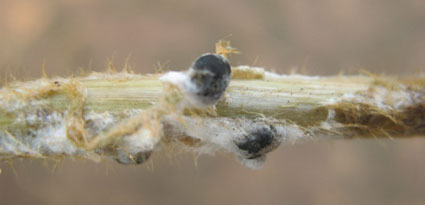
Figure 4. White mold sclerotia on soybean stem.
Figure 5. White mold disease cycle. Click here or on the image above for a larger view.
Wet, cool conditions are required throughout the white mold disease cycle, including germination of the sclerotia in the soil, spore release, infection of soybean flowers by spores and spread of white mold from plant to plant.
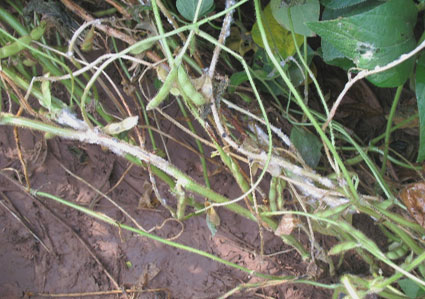
Figure 6. White mold on soybean stems.
Early establishment of a dense soybean canopy increases the likelihood that the high-humidity conditions required for white mold development will occur. Early canopy closure is a goal for many soybean producers, especially in northern locations and growing environments where solar radiation may be limited, as it important for maximizing light interception and yield. Soybean management practices such as early planting and narrow rows can help achieve earlier canopy closure. Unfortunately, these practices can also encourage white mold development.
The North Central Plant Health Initiative has developed the following list of risk factors for white mold.
Weather: Moderate temperatures (<85 °F), normal or above normal precipitation, soil moisture at field capacity or above, and prolonged morning fog and leaf wetness (high canopy humidity) at and following flowering into early pod development.
Early canopy closure due to early planting, high plant population, narrow rows, excessive plant nutrition and optimal climatic conditions creates dense canopy and increased apothecia density.
History of white mold in the field, density of the white mold pathogen, apothecia present on soil surface at flowering, distribution of pathogen/disease in field.
Soybean variety planted. Plant structure and physiological functions govern variety reaction to white mold. Varieties range from partially resistant to highly susceptible.
Field/cropping history. Pathogen level will gradually increase if:
Weed management systems. Inoculum will increase if control of broadleaf weeds is ineffective. Some herbicides used in rotation systems may be suppressive to white mold.
Topography of field. Pockets of poor air drainage, tree lines and other natural barriers that impede air movement will create a favorable micro-environment for white mold development.
Pathogen introduction:
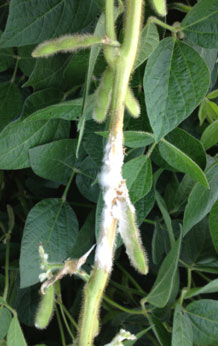
Figure 7. Infected soybean stem.
White mold is a disease of high yield potential soybeans. Often, the better the establishment and growth of the crop, the more likely it will be damaged by white mold. Management practices that may be useful for reducing the severity of white mold infection may also limit the yield potential of the crop; consequently, an integrated management strategy for white mold often involves weighing the tradeoffs between pushing for maximum yield vs. protecting against disease based on the white mold risk in a given field.
No single practice will be effective in completely controlling white mold, but several options are available to help reduce disease pressure. Current options include disease avoidance, variety selection, changes in cropping systems including tillage and rotation, and adjusting production methods such as planting practices, chemical applications and weed control.
White mold spreads either by movement of spores or sclerotia from field to field. Spores are airborne and may originate from any field that has had white mold in the past. However, spores generally do not move long distances, as they originate near the soil surface and commonly stay contained below the crop canopy. Spread over longer distances is usually due to movement of sclerotia.
Sclerotia move from field to field in harvest equipment or in contaminated seed. Harvest equipment should be thoroughly cleaned when moving from infected to non-infected fields. Harvesting infected fields last provides additional safety. Because sclerotia are roughly the size of soybean seed, they can’t be easily separated by the combine. Soybeans harvested from infected fields are most likely loaded with sclerotia. Planting these soybeans would place them at the ideal depth for germination and infection of that crop and field. Growers should absolutely not save seed from infected fields.
Corteva Agriscience avoids growing seed beans in fields with a history of white mold. In addition, seed is thoroughly cleaned and inspected to ensure that it is disease-free. Seed cleaning with a gravity table or centrifugal tower is essential to remove sclerotia. Fungicide seed treatments can help ensure that no disease is transmitted by mycelia present on seed.
There is no absolute resistance available to white mold (all varieties can get the disease under severe pressure), but differences in tolerance exist between varieties. Pioneer variety ratings range from 2 to 7 on a scale of 1 to 9 (9 = resistant). Ratings reflect varietal differences in the rate at which infection develops as well as the extent of damage it causes and are based on data from multiple locations and years. Choosing varieties that rate high for tolerance is an important management practice in areas that commonly encounter white mold. Your local Pioneer sales professional can suggest white mold tolerant varieties with a complete package of traits needed for top soybean production in your area.
Variety maturity is also an important consideration. Longer maturity varieties can help maximize yield potential, but they also have a longer window of flowering, which extends the period of time that senescing flowers are present and susceptible to infection.
Research studies have shown that no-till is generally superior to other tillage systems in limiting white mold development by leaving sclerotia to deteriorate on the soil surface. Sclerotia germinate from the top two inches of soil. Below that depth, they can remain dormant for five or more years. Because of its longevity in the soil, it is difficult to devise a strategy to control white mold with tillage. Deep tillage buries sclerotia from the soil surface but may also bring prior sclerotia into their zone of germination.
Rotation with a non-host crop can help reduce disease pressure in a field. Non-host crops include corn, sorghum, and small grains. Susceptible crops to avoid in a rotation include alfalfa, clover, sunflower, canola, edible beans, potato, and others. Depending on soybean tolerance, field history and other factors, more than one year away from soybeans may be required. Including a small grain crop in the rotation can be particularly helpful, as the canopy is dense enough to trigger formation of apothecia from the sclerotia in the soil but there is no host crop to infect. However, because of the longevity of sclerotia in the soil, crop rotation is only a partial solution.
Later planted soybeans are generally shorter and less branched and therefore later to reach canopy closure. Some planting date studies show that later planting results in less incidence of white mold. However, yields are generally reduced when planting is delayed past mid-May in northern states. The tradeoff between less yield reduction due to white mold but more yield reduction due to late planting may not be favorable, especially in years of low disease pressure
Row spacing and seeding rate both influence soybean canopy closure and density, which affect development of white mold. However, given that early canopy closure is generally favorable to yield, adopting wider row spacings or lower seeding rates to manage white mold may also reduce yield potential.
The most common row spacings for soybeans in the U.S. are 15 inches and 30 inches. Drilled soybeans in row spacings less than 15 inches were once common but have declined in recent years. Numerous studies over many years have demonstrated a yield advantage for narrow-row (<30 inches) soybeans. A Pioneer review of several university trials found an average yield benefit of around 4 bu/acre for drilled or 15-inch row soybeans compared to 30-inch rows (Jeschke and Lutt, 2016).
Research has shown that seeding rate is likely a more important factor affecting white mold development than row spacing (Lee et al., 2005). In fields with high risk of white mold, seeding rates should be sufficient for uniform stand establishment, but shouldn’t be aggressively high. Actual rates will vary depending on planting date, seedbed conditions, and seed quality. A multi-state university study found that wider rows and reduced seeding rates were both effective at reducing white mold severity, but also reduced soybean yield when white mold did not develop (Webster et al., 2022). Results suggested that wider rows and reduced seeding rates as tactics to manage white mold should be reserved for fields with a history of white mold where disease is likely to occur.
White mold has over 400 plant hosts, including many broadleaf weeds. Host weeds that are also common weed species throughout soybean growing areas include lambsquarters, ragweed, pigweed, and velvetleaf. In addition to acting as host to the disease, weeds can also increase canopy density, which favors disease development.
Despite the best use of cultural practices to limit the incidence of white mold, weather and other conditions conducive to disease development may still cause heavy infestations. In cases of high disease risk, a foliar application of a chemical product or a soil application of a biological product may help reduce disease severity and protect soybean yield.
Products labeled for white mold control or suppression include several foliar fungicides (Table 1), a biological fungicide (Contans® fungicide), and the herbicide lactofen (active ingredient in Cobra® herbicide and Phoenix® herbicide).
Chemical treatments generally will not provide complete control of white mold. Reduction of disease in university field trials has ranged from 0 to 60% (Mueller et al., 2015). Consequently, chemical treatments need to be used as part of an integrated management strategy for white mold.
Table 1. Fungicides labeled for control of white mold in soybeans with an efficacy of “fair” or better (Wise, 2025).
| Fungicide Trade Name | Active Ingredient | White Mold Efficacy |
|---|---|---|
| Aproach® 2.08 SC | picoxystrobin | good |
| Proline® 490 SC | prothioconazole | fair |
| Domark® 230 ME | tetraconazole | fair |
| Topsin-M® | thiophanate-methyl | fair |
| Omega® 500 DF | fluazinam | good |
| Endura® 0.7 DF | boscalid | very good |
| Propulse® 3.34 SC | fluopyram, prothioconazole | good |
| Delaro® 325 SC | trifloxystrobin, prothioconazole | fair |
| Delaro® Complete 3.83 SC | fluopyram, trifloxystrobin, prothioconazole | fair |
| Viatude® 2.09 SC | picoxystrobin, prothioconazole | fair |
White mold efficacy is based on R1-R2 application timing, and lower efficacy is obtained at R3 or later application timings, or if disease symptoms are already present at the time of application.
Optimum application time of fungicides for white mold control in soybeans is the R1 to R2 growth stage, also known as the beginning bloom or first flower stage (Mueller et al., 2015). For much of the U.S. Corn Belt, the R1 stage coincides with the first two weeks of July when the vegetative growth stage is typically about V7 to V10 (Pedersen, 2009). Fungicides applied up to the R3 stage can provide some benefit in reducing white mold.
Fungicides have little activity on established disease and must be applied prior to white mold invasion of senescing flowers. Applications made just prior to pathogen invasion have helped reduce disease severity in some studies. Because soybeans normally flower for 30 days or more (R1 to R5) and fungicides for white mold control have maximum residual activity of about two weeks, a second application may be necessary if conducive environmental conditions persist into mid-summer.
One drawback to later (R3) fungicide application is the potential for reduced canopy penetration. Though soybeans grown in 30-inch rows at moderate seeding rates may allow for good penetration of the lower canopy at R1, spray coverage of the lower nodes becomes increasingly difficult with continued vegetative growth. As depicted in Figure 5, the lower canopy can remain relatively wet or humid, providing the appropriate environment for pathogenicity. Thus, it is essential for spray droplets to reach the lower two-thirds of the soybean canopy in order to obtain satisfactory disease control.
A University of Wisconsin research trial conducted near Hancock, WI in 2016 found significant increases in soybean yield associated with Aproach® fungicide treatment under high levels of white mold pressure (Figure 8). A single treatment at the R3 growth stage increased yield by 11.5 bu/acre and sequential applications at the R1 and R3 stages increased yield 16 bu/acre compared to the non-treated check.
Figure 8. Yield of soybeans treated with Aproach® fungicide at the R3 growth stage and the R1 and R3 stages compared to non-treated soybeans in a Univ. of Wisconsin trial at Hancock, WI, in 2016 (Smith et al., 2016). Click here or on the image above for a larger view.
Means labeled with the same letter are not significantly different based on Fisher’s Least Significant Difference (LSD; α=0.05).
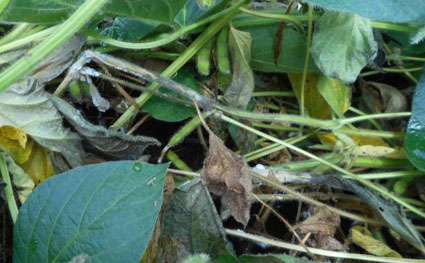
Figure 9. Soybean plants infected with white mold.
Corteva Agriscience on-farm research trials were conducted in 2017 at locations near Orchard, NE and Edgar, WI that experienced high white mold pressure. Both trials compared sequential applications at the R1 and R3 growth stages and single-pass treatments at both R1 and R3 to a non-treated check. The Wisconsin trial was non-replicated, and the Nebraska trial included two replications. The two-pass fungicide program increased yield by an average of 13.3 bu/acre in these trials (Table 2). The R3 and R1 treatments increased yield by an average of 8.7 and 6.7 bu/acre.
Table 2. Soybean yield associated with Aproach® fungicide treatments in on-farm trials with heavy white mold pressure in Wisconsin and Nebraska.
| Fungicide Treatment | Edgar WI | Orchard NE | Average | Yield Advantage |
|---|---|---|---|---|
| —————— bu/acre —————— | ||||
| Aproach® (R1+R3) | 66.6 | 55.9 | 61.3 | +13.3 |
| Aproach® (R3) | 57.7 | 55.6 | 56.7 | +8.7 |
| Aproach® (R1) | 61.9 | 47.4 | 54.7 | +6.7 |
| Non- treated |
54.8 | 41.2 | 48.0 | |
Figure 10. Corteva Agriscience on-farm fungicide research trial near Edgar, WI comparing Aproach® fungicide applied at R1, R3, and R1+R3 growth stages to a non-treated check under heavy white mold pressure (September 11, 2017). Click here or on the image above for a larger view.
Figure 11. Corteva Agriscience on-farm fungicide research trial near Orchard, NE comparing Aproach® fungicide applied at R1, R3, and R1+R3 growth stages to a non-treated check under heavy white mold pressure (August 23, 2017) Click here or on the image above for a larger view.
Lactofen, the active ingredient in Cobra herbicide, and Phoenix® herbicide is for post-emergence weed control in soybeans. In addition, it is a potent elicitor of the phytoalexin glyceolin (Nelson et al., 2001). Phytoalexins are antimicrobial) substances produced by plants in response to invasion by certain pathogens or by chemical or mechanical injury (Agrios, 1988).
Studies have shown that the optimum application time for Cobra herbicide is at R1, which is identical to timing recommendations for foliar fungicides. Although small yield improvements were observed with V4 to V5 Cobra herbicide treatments, yield increases were larger and more consistent with applications at R1 (Figure 6). Despite heavy disease pressure (48% incidence), Cobra herbicide has been shown to reduce disease incidence and increase yield of susceptible soybean varieties (Oplinger et al., 1999). However, a moderately resistant variety showed no response to Cobra herbicide and produced a higher yield than a treated susceptible variety. Due in part to unpredictable disease levels and variations in varietal tolerance to white mold, yield increases with Cobra herbicide have tended to be highly variable (Nelson et al., 2002).
Herbicides with PPO inhibiting sites of action, such as Cobra, herbicide usually cause moderate levels of leaf necrosis. Although the reduction in leaf area from this necrosis is likely a contributing factor in white mold control with Cobra herbicide, yield loss may result in the absence of disease (Dann et al., 1999; Kyle, 2014). Producers should use caution when considering the widespread use of Cobra herbicide, especially on moderately resistant varieties when environmental conditions do not favor disease.
Contans® WG fungicide: Contans fungicide is a biological control agent of white mold. The product contains the soil fungus Coniothyrium minitans, which acts as a parasite attacking the overwintering survival structures (sclerotia) of white mold. Contans fungicide is applied to the soil, its spores germinate with sufficient moisture, and the fungus can destroy sclerotia if given adequate time. According to the manufacturer, Contans fungicide should be applied at least three months prior to white mold infection, and soil-incorporated immediately following application to a depth of at least 4 inches. Contans fungicide has been evaluated in both greenhouse and field studies (Hao et al., 2010). In both cases, efficacy has been good, as reduced apothecia number and improved soybean yield have been observed. Although Contans fungicide may be fall- or spring-applied, fall applications have performed better than those done in spring.
Download your copy of Pioneer's Corn and Soybean Scouting Calendar. It's your guide to the diseases and pests that threaten your yield and when to look for each one.
From enhanced in-season protection to improved harvestable yield, Aproach® fungicide delivers tangible results.
See the Benefits
The foregoing is provided for informational use only. Please contact your Pioneer sales professional for information and suggestions specific to your operation. Product performance is variable and depends on many factors such as moisture and heat stress, soil type, management practices and environmental stress as well as disease and pest pressures. Individual results may vary. Pioneer® brand products are subject to the terms and conditions of purchase which are part of the labeling and purchase documents.
